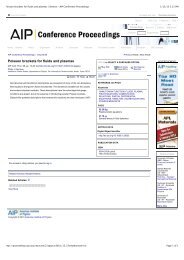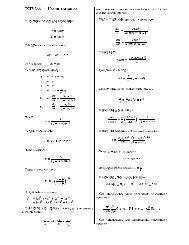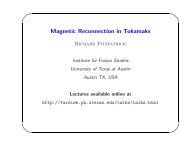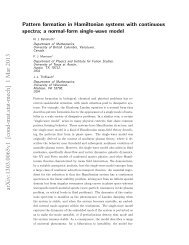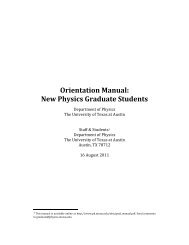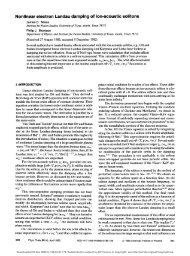Magnetic Fields and Magnetic Diagnostics for Tokamak Plasmas
Magnetic Fields and Magnetic Diagnostics for Tokamak Plasmas
Magnetic Fields and Magnetic Diagnostics for Tokamak Plasmas
Create successful ePaper yourself
Turn your PDF publications into a flip-book with our unique Google optimized e-Paper software.
<strong>Magnetic</strong> fields <strong>and</strong> tokamak plasmas<br />
Alan Wootton<br />
the time t 1 the integration starts. On tokamaks this gate is often used to help reduce errors from<br />
misaligned pick-up coils. For example, tokamaks have a large toroidal field <strong>and</strong> a much smaller<br />
poloidal field. There<strong>for</strong>e if the pick-up coil used to measure the poloidal field is misaligned even<br />
by a small amount, the resulting component of the toroidal field which is picked up (as dB/dt)<br />
can be significant. However the toroidal field usually evolves on a much slower time scale than<br />
the poloidal field, <strong>and</strong> in fact it is usually time independent at the time the poloidal field is<br />
initiated. There<strong>for</strong>e the integrator gate can be opened when the toroidal field is time<br />
independent, <strong>and</strong> there<strong>for</strong>e the induced voltage in the misaligned pick-up coil is independent of<br />
the toroidal field.<br />
Integrator gate<br />
εin<br />
Ω<br />
C<br />
ε out<br />
.<br />
Figure 1.5. An active integrator circuit.<br />
If the data is digitized, integration can be per<strong>for</strong>med numerically. Sufficiently fast systems now<br />
exist <strong>for</strong> “real time” integration; the integration can be per<strong>for</strong>med in µs so that integrated signals<br />
suitable <strong>for</strong> real time feedback control can be obtained. A p bit digitizer has a resolution of 1 part<br />
in 10 p , e.g. an 8 bit system has a resolution of 1 in 256, while a 10 bit system has a resolution of<br />
1 part in 1024. This can be a limitation if we intend to investigate large but low frequency<br />
magnetic fields in the presence of small, high frequency fields. An example is that of trying to<br />
measure the equilibrium poloidal field in the presence of Mirnov oscillations. The pick-up coil<br />
output is dominated by the voltage produced by the time derivative of the small but high<br />
frequency component. Avoiding saturating the input by the higher voltage, high frequency<br />
component means that the resolution of the low frequency fields is now restricted. If we want to<br />
use the full capability of the digitizer in recording the lower frequency fields, then the solution is<br />
to filter the signal <strong>and</strong> only allow frequencies below a certain value to be recorded, i.e. use the<br />
filter described above with reference to Figures 1.2 <strong>and</strong> 1.4.<br />
Intuition suggests that if a time varying wave <strong>for</strong>m is sampled sufficiently fast then the original<br />
wave <strong>for</strong>m can be recovered. However, we must determine how close the samples must be, <strong>and</strong><br />
how to interpolate between adjacent points. The sampling theorem provides answers to these<br />
questions. An original signal x(t) can be recovered from sample values x(nt s ), with t s the sample<br />
time, by locating sinc functions at nt s with amplitudes x(nt s ). The signal x(t) can only be<br />
11



